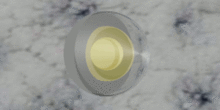 An artist's impression of BLITS | |
| Mission type | Technology |
|---|---|
| Operator | Roskosmos ILRS network |
| COSPAR ID | 2009-049G |
| SATCAT no. | 35871 |
| Mission duration | Achieved: 3.5 years Planned: 5 years |
| Spacecraft properties | |
| Manufacturer | FSUE-IPIE |
| Launch mass | 7.53 kilograms (16.6 lb) |
| Start of mission | |
| Launch date | 17 September 2009, 15:55:07 UTC[1] |
| Rocket | Soyuz-2-1b/Fregat |
| Launch site | Baikonur Site 31/6 |
| End of mission | |
| Last contact | March–April 2013 |
| Orbital parameters | |
| Reference system | Geocentric |
| Regime | Low Earth |
| Semi-major axis | 7,197.67 kilometres (4,472.42 mi) |
| Eccentricity | 0.0004373 |
| Perigee altitude | 823 kilometres (511 mi) |
| Apogee altitude | 829 kilometres (515 mi) |
| Inclination | 98.55 degrees |
| Period | 101.28 minutes |
| RAAN | 105.39 degrees |
| Argument of perigee | 71.58 degrees |
| Epoch | 25 February 2014, 08:51:29 UTC[2] |
BLITS (Ball Lens In The Space) is a Russian satellite launched on September 17, 2009, as a secondary payload on a Soyuz-2.1b/Fregat, from the Baikonur Cosmodrome in Kazakhstan. The satellite is totally passive and spherical, and is tracked using satellite laser ranging (SLR) by the International Laser Ranging Service.[3] The design of BLITS is based on the optical Luneburg lens concept. The retroreflector is a multilayer glass sphere; it provides uniform reflection characteristics when viewed within a very wide range of angles, and can provide a cross-section sufficient for observations at low to medium orbit heights. A similar design was already tested on a smaller laser reflector carried on board of the METEOR-3M spacecraft launched on December 10, 2001.[4]
The purpose of the mission was to validate the spherical glass retroreflector satellite concept and obtain SLR (Satellite Laser Ranging) data for solution of scientific problems in geophysics, geodynamics, and relativity. The BLITS allows millimeter and submillimeter accuracy SLR measurements, as its "target error" (uncertainty of reflection center relative to its center of mass) is less than 0.1 mm. An additional advantage is that the Earth's magnetic field does not affect the satellite orbit and spin parameters, unlike retroreflectors incorporated into active satellites. The BLITS allows the most accurate measurements of any SLR satellites, with the same accuracy level as a ground target.[5]
The satellite was inserted into an 832 km (517 mi) Sun-synchronous orbit, with an inclination of 98.85º.[6] The satellite was spinning at a spin period of 5.6 seconds around the axis normal to its orbit plane, allowing laser light to be reflected in short bursts because only half of the satellite is covered in a reflective coating. As the satellite is made of glass, minimal in-flight spin slowdown was expected since there were no conducting parts where currents interacting with the Earth magnetic field can be induced.[7] The expected operative life was at least five years, but the mission was interrupted in 2013 after a collision with space debris.[7][8]
- ^ "BLITS". International Laser Ranging Service. Archived from the original on 2013-10-17. Retrieved 2014-02-25.
- ^ "BLITS Satellite details 2009-049G NORAD 35871". N2YO. 25 February 2014. Retrieved 26 February 2014.
- ^ Pearlman, M.; Arnold, D.; Davis, M.; Barlier, F.; Biancale, R.; Vasiliev, V.; Ciufolini, I.; Paolozzi, A.; Pavlis, E. C.; Sośnica, K.; Bloßfeld, M. (November 2019). "Laser geodetic satellites: a high-accuracy scientific tool". Journal of Geodesy. 93 (11): 2181–2194. Bibcode:2019JGeod..93.2181P. doi:10.1007/s00190-019-01228-y. S2CID 127408940.
- ^ "Spherical Retroreflector with an Extremely Small Target Error: International Experiment in Space" (PDF). 13th International Workshop on Laser Ranging. Toward Millimeter Accuracy. NASA.
- ^ "BLITS: spin parameters and its optical response measured by the Graz 2kHz SLR system" (PDF).
- ^ Sośnica, Krzysztof; Jäggi, Adrian; Meyer, Ulrich; Thaller, Daniela; Beutler, Gerhard; Arnold, Daniel; Dach, Rolf (October 2015). "Time variable Earth's gravity field from SLR satellites". Journal of Geodesy. 89 (10): 945–960. Bibcode:2015JGeod..89..945S. doi:10.1007/s00190-015-0825-1.
- ^ a b Cite error: The named reference
EOportalwas invoked but never defined (see the help page). - ^ "Russian BLITS Satellite hit by Space Debris". Spaceflight101: Space News and Beyond. 9 March 2013. Archived from the original on 2016-10-05. Retrieved 16 April 2020.
{{cite web}}: CS1 maint: unfit URL (link)